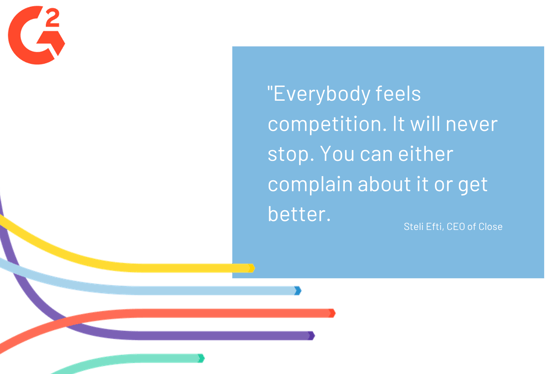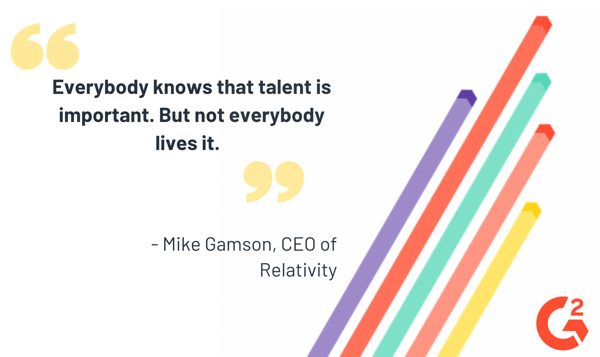Any time the word “hyper” precedes something, the connotation implies intense and overwhelming feelings.
Hypercritical, hyperthermia, hyper wakefulness - all of those words are associated with too much of one thing. However, if you understand your situation before it progresses to a “hyper” state, it should be manageable. You can prepare mentally for a lot of criticism, bundle up for extreme temperatures, and meditate to calm yourself down.
In business, there are two situations that call for some serious preparation and adjustments: hyper-growth and hyper-competition.
Hyper-growth and hyper-competition
Competing in a hyper-competitive space can be intimidating, and managing hyper-growth internally calls for some serious onboarding efforts.
At G2’s first-ever REACH conference in Chicago, Steli Efti, the CEO of Close, and Mike Gamson, the CEO of Relativity, spoke on tackling both of these situations as a business looking to thrive.
How to win in a hyper-competitive space
There is not a single business that does not feel the sting of competition. There will always be another business that is more efficient, has better marketing, or outsells you. However, sitting around and moping about it will get you nowhere.
Steli Efti of Close feels strongly about this as well. At REACH this year, he opened his talk on hyper-competition by saying, “Everybody feels competition. It will never stop. You can either complain about it or get better.”

So let’s stop whining and take a look at some of his tips on outselling your competition.
1. Master the fundamentals
Before you can apply a bunch of complicated sales strategies, you first need to master the fundamentals of selling. Nail the steps of the selling process and understand how those steps interact with one another.
2. Rethink your communication
The way you communicate the benefits of your product or service with your audiences is almost as important as the offering itself. When interacting with customers during the sales process, focus on results-driven communication. Keep that objective in mind when communicating and always come back to it.
For Efti, this means rethinking the definition of sales. “Sales is communicating with an end goal in mind. Your customers should know what to do next.”
3. Out-teach the competition
Sales is all about showing a prospect the benefit your product or service can provide them. If you do a better job teaching people about your business, and educating them on the value, you will outsell your competition.
4. Focus on the individual user
To thrive in a hyper-competitive space means to outsell your competition, and that will simply not happen unless you focus on the individual user. Don’t walk into a sales pitch with a script in hand. Identify their pain points, and restructure the conversation around how your business can relieve them.
If this means rethinking your entire sales structure, so be it. Nobody wants to talk to a robotic salesperson about a product they have seen one million times. They want to have a conversation with another human being that focuses on their wants and needs.
5. Get intimate
You don’t have to send them flowers on Valentine’s Day, but be compassionate when selling. Respect the engagement you are having with the other person. Understand the user and create a relationship. Efti is a big believer in the influence of intimacy. “People don’t remember the product. They remember how you made them feel. That is the power of selling.”
How to win during times of hyper-growth
Knowing how to succeed in a hyper-competitive space is a good step, but you can’t do that without a well-equipped team of ready-to-go sellers.
Mike Gamson of Relativity talked about tackling hyper-growth at REACH this year and gave audience members some tips on navigating through it.
1. Recognize you are growing
The first step of almost any business situation is to first recognize that you are in it in the first place. Acknowledge the fact that your business is experiencing hyper-growth. This way, you can’t be blindsided by the things that come with it.
2. Get qualified people onboarded
This one might seem obvious, but you need to find the best talent for your business and get them onboarded so they can start contributing. Gamson pointed out this obvious fact, but then also recognized that it is easier said than done. “Everybody knows that talent is important, but not everybody lives it.”

3. Be realistic about forecasting
Hyper-growth is a generally positive time for businesses, but it can also bring some slower turnaround times. New sellers will have to adjust to the company culture and processes before they can contribute, and this can take some time. When forecasting sales, be realistic and account for the time it takes to onboard and get comfortable.
4. Own your mistakes quickly
You are going to make mistakes. It is inevitable. Own your mistakes as soon as you realize you’ve made them. Whether this be about the diversity in the workplace or the onboarding process as a whole, own up quickly so things can be taken care of.
Focus up
Our speakers at REACH gave us some great insight into their own personal experiences with selling and what worked for them when they faced hyper-competitive spaces and hyper-growth.
|
Did you miss REACH this year? Don’t sweat it. Next year is going to blow you away. Don’t miss REACH 2020!

|
 by Soundarya Jayaraman
by Soundarya Jayaraman
 by Lauren Ventura
by Lauren Ventura
 by John Williamson
by John Williamson